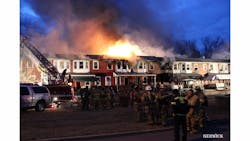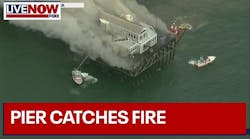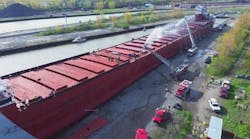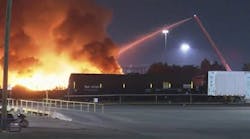JUNCTION FIRE COMPANY
Chief: Scott Beers
Personnel: 38 volunteer firefighters
Stations: 1
Apparatus: 1 pumper, 1 quint, 1 rescue, 1 tanker, 1 brush truck
Population: Granville Township 4,895; Juniata Terrace Boro, 525
Area: 42 square miles
On Thursday, March 27, 2014, an eight-alarm fire destroyed or damaged 23 rowhomes in Juniata Terrace, PA, displacing 32 residents. The fire required the resources of 41 fire and EMS departments in Mifflin, Juniata, Centre and Huntington counties in central Pennsylvania. Two tanker shuttles were established to provide an adequate water supply after the municipal water system hydrants lost pressure.
The two-story rowhomes were built of brick construction in 1925 by the British Crown Rayon Co. for its mill workers. Each unit, complete with electricity and running water, contained approximately 1,300 square feet of living space. A common loft that ran above all of the units was built on top of the original roof, which was above the fire walls. Battery-operated smoke alarms were present in each home.
The Junction Fire Company of Lewistown (Granville Township) was dispatched to a reported structure fire at 332 Terrace Boulevard at 6:36 P.M. Responding on the call were Engine 15-1, Quint 15-1, with a 75-foot aerial, Tanker 15-1 and Heavy Rescue 15-1 with 18 firefighters under the command of Fire Chief Scott Beers.
Also dispatched as automatic mutual aid were Granville Fire Company Engine 16-1 and Tanker 16-1; West Granville Fire Company Engine 17-1 and Tanker 17-1; Lewistown’s Brooklyn Hose Company Engine 13-1; East Derry Fire Company Engine 2-1 and Squad 2-1, carrying rapid intervention team (RIT) tools and towing an air trailer; Burnham Fire Company Truck 1-1, a 75-foot aerial ladder; Reedsville Fire Company Heavy Rescue 6-1; and Fame EMS ALARM
While enroute, Beers requested a second alarm at 6:40 P.M., after observing a smoke column from the Junction Fire Station, a quarter-mile from the fire. Responding on the second alarm were Highland Park Hose Company in Lewistown (Derry Township) Engine 4-1; McVeytown Fire and EMS Engine 18-1; Mifflintown Hose Company 1 Engine 22; Reedsville Fire Company Engine 6-1 and Tanker 6-1; Lewistown’s United Fire and Rescue Engine 11-1 and Truck 11-1, a 95-foot aerial platform; Lewistown’s City Hook and Ladder Rescue/Pumper 14-1; Milroy Hose Company Tanker 7-1; Decatur Fire Company Tanker 5-1; Belleville Fire Company Tanker 24-1; and Fame EMS Rehab Unit 12-1. The second-alarm units were staged and supplied manpower for initial firefighting operations and assisted with setting up tanker shuttle operations because the hydrant system was failing to supply enough water for suppression operations. A staging area was established three blocks away in a church parking lot.
Initial operations
Junction Quint 15-1 was first to arrive on scene at 6:42 with Beers on board and reported that the fire was located at the rear of the block of rowhomes in units 332, 334 and 336. All residents were out of the entire block of rowhomes upon the arrival of the fire department. Junction Engine 15-1 and Quint 15-1 were positioned on the C side (rear) of the building. Firefighters advanced three 1¾-inch attack lines from Engine 15-1 and Quint 15-1. Brooklyn Hose Engine 13-1 laid an 850-foot, five-inch hydrant supply line to Junction Quint 15-1. After the water supply was established, firefighters used an additional 1¾-inch attack line from Brooklyn Hose Engine 13-1.
Lewistown United Engine 11-1 and Truck 11-1, Granville Engine 16-1 and Burnham Truck 1-1 were positioned on the A side (front) of the building. Lewistown United Engine 11-1 laid a 1,350 foot, five inch hydrant supply line to supply to Truck 11-1. Firefighters placed four 1¾-inch lines and one 2½-inch attack line into operation from Lewistown United Engine 11-1.
At 7:30 P.M., Beers ordered all operations to change to defensive mode. More aerial apparatus were requested in addition to the aerial apparatus on the first two alarms.
Lewistown City Truck 14, a 100-foot aerial, was positioned on side A on the opposite side of the divided boulevard and supplied by the tanker shuttle on side A with a 1,500-foot, five-inch line. Newton Wayne Engine 26-1 pumped to Reedsville Engine 6-1, which supplied Truck 14. Huntington Regional Truck 65, a 105-foot aerial, was positioned side C and supplied by the tanker shuttle. Mount Union Truck 7, a 100-foot aerial, was positioned on side A and supplied by the tanker shuttle.
Additional water supplies needed
Each hydrant on the municipal water system was capable of only supplying 500 gallons per minute. The water system would become depleted when 90,000 gallons of water was used. Beers and local water company officials determined that additional water supplies would be needed.
Two tanker fill sites were established at 7:45 P.M. Decatur Engine 5-1 was assigned to a fill site about a half-mile away at a hydrant at Dusqene Way and 103 North. Yeagertown Engine 3-1 was assigned to the second draft site at the fishing access area on the Juniata River three-quarters of a mile from the fire.
At 8 P.M., two tanker shuttles were established to supply additional water for firefighting operations. One dump site was established on side A at the intersection of Delaware Avenue and 103 North using two 2,500-gallon portable tanks. Newton Wayne Engine 26-1 drafted out of the portable tanks and pumped a 1,500-foot, five-inch line to Reedsville Engine 6-1 to supply Mount Union Truck 7-1.
A second dump site using two 2,100-gallon portable tanks and one 2,500-gallon portable tank was established in the Lewistown Christian & Missionary Alliance Church parking lot for C-side operations. McVeytown Engine 18-1 drafted out of the portable tanks and pumped a 1,500-foot, five-inch line to Beale Township Engine 52-1, which relay pumped to Brooklyn Hose Engine 13-1. Engine 13-1 pumped to Junction Quint 15-1, which relay pumped to Huntington Regional Truck 65.
After eight tankers responded on the first and second alarms, 11 more additional mutual aid tankers were requested. Responding were Allensville Volunteer Fire Company Tanker 25-1, Newton Wayne Volunteer Fire Company Tanker 26-1, Mifflintown Hose Company 1 Tanker 23, East Salem Tanker 63-1, Boalsburg Fire Company Tanker 319, Centre Hall Fire Company Tanker 419, Gregg Township Fire Company Tanker 720, Walker Township Fire Company Tanker 1619, Mill Creek Fire Company Tanker 20, Petersburg Fire Company Tanker 4 and Three Springs Fire Company Tanker 12.
Additional engines, trucks, squads and ambulances were requested throughout the incident for manpower and equipment resources: East Derry Air 2-1 (a mobile air compressor), Highland Park Squad 4-1, Milroy Engine 7-2, Milroy EMS Ambulance 7-2; Fame EMS Ambulances 12-2, 12-4 and 12-6, Brooklyn Hose Engine 13-2, Junction Squad 15-1, Granville Utility 16-1, West Granville Squad 17-1, McVeytown EMS Ambulances 18-1 and 18-3, Big Valley Ambulance 23-1, Belleville Engine 24-1, Allensville Engine 25-1Newton Wayne Engine 26-1, McCalisterville Engine 42, Mifflin Engine 32-1, Beale Township Engine 52-1, Undine Fire Company of Bellefonte Truck 216, Boalsburg Engine 314, Centre Hall Engine 414, Alpha Fire Company of State College Truck 516 and Truck 517, Life Link MICU 25, Huntington Regional Engine 65-1, Smithfield Tower 10, Mount Union Ambulance 701 and Stone Creek Engine 19-1.
In addition to the four aerial master streams, firefighters using 1¾-inch attack lines moved into the homes as conditions allowed. Six 1¾-inch handlines were used on side C and firefighters operated four 1¾-inch attack lines and one 2½-inch attack line on side A.
Beers declared the fire under control at 12:09 A.M. on March 28. Mutual aid departments were released at various times and the last Junction units left the scene at 1:59 A.M.
Conclusion
Some 175 firefighters operated seven engines, six trucks and 19 tankers to control the fire. Two tanker shuttles and two municipal hydrants supplied approximately 250,000 gallons of water used to extinguish the fire. Thirty-three EMS personnel also responded to the scene. Three firefighters suffered minor injuries and were transported to Geisinger-Lewistown Hospital for treatment. No civilians were injured. Fire spread from the original rowhouse at 332 to units on both sides destroying or damaging units 324, 326, 328, 330, 334, 336, 338, 340, 342, 346, 348 and 350.
An origin-and-cause investigation into the fire was conducted by the Lewistown Fire Department fire investigator. After a six-hour investigation, it was determined that the fire was caused by unattended cooking by the occupants of 332 Terrace Boulevard. Damage was estimated at $3.7 million, including $3 million to the building and $700,000 to the contents.
LESSONS LEARNED
PROBLEMS
• The fire department was not accustomed to fighting a fire with a common loft.
• The building had roofs built on top of the original roof that was constructed above the fire wall.
• The municipal water system hydrants lost pressure after 90,000 gallons of water was used. Two tanker shuttles were established in order to have an adequate water supply.
• It took one hour to secure the utilities during the incident.
SUCCESSES
• The fire department contained fire to the center of the block.
• Firefighters knew the layout of the homes from previous incidents at the location. Over the past 15 years, firefighters have successfully held three working fires to one house.
The fire department is instituting more extensive training on rowhouse-type firefighting along with current monthly training. A critique of the fire was held within the department about better ways to “attack” fires of this type. Firefighters talked to community about the incident and spoke with the Boro Council about updating building ordinances and upgrading the water system infrastructure.
—Jay K. Bradish






